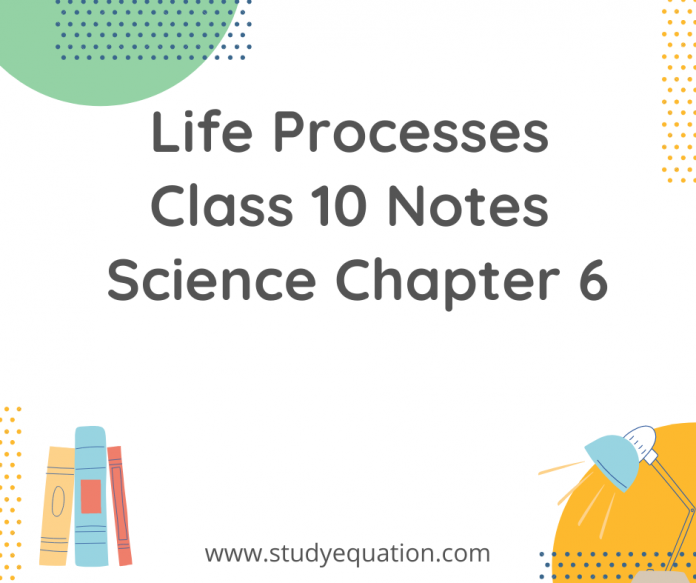Life Processes Class 10 Notes Science Chapter 6, here we are going to give you a summary of Life Processes Class 10 Notes Science Chapter 6. In this chapter we will study about the different life processes that help a human keep it self alive. Your all doubts from the chapter of Life Processes Class 10 Notes Science Chapter 6 of class 10 will be cleared from this summary.
Read more: Heredity and Evolution Class 10 Notes Science Chapter 9
Table of Contents
Life Processes Class 10 Notes Science Chapter 6 – Introduction
Movements over very small scales will be invisible to the naked eye – movements of molecules, This invisible molecular movement necessary for life. Viruses do not show any molecular movement in them (until they infect some cell), and that is partly why there is a controversy about whether they are truly alive or not.
Living organisms are well-organised structures. They can have tissues, tissues have cells, cells have smaller components in them, and so on. This organised, ordered nature of living structures is very likely to keep breaking down over time.Then the organism will no longer be alive. So living creatures must keep repairing and maintaining their structures. Since all these structures are made up of molecules, they must move molecules around all the time.
WHAT ARE LIFE PROCESSES?
Maintenance functions of living organisms must go on even when they are not doing anything particular. Even if we are just asleep, this maintenance job has to go on. The processes which together perform this maintenance job are life processes. These maintenance processes are needed to prevent damage and break-down. Energy is needed for these maintenance processes. This energy comes from outside the body of the individual organism.
The outside sources of energy could be quite varied. The environment is not under the control of the individual organism. These sources of energy, therefore, need to be broken down or built up in the body, and must be finally converted to a uniform source of energy that can be used for the various molecular movements needed for maintaining living structures, such as the kind of molecules the body needs to grow.
Oxidising-reducing reactions are some of the most common chemical means to break-down molecules.
When chemical reactions use the carbon source and the oxygen for energy generation, they create by-products that are not only useless for the cells of the body, but could even be harmful. These waste byproducts are therefore needed to be removed from the body and discarded outside by a process called excretion.
Life Processes Class 10 Notes Science Chapter 6 : NUTRITION
We also need materials from outside in order to grow, develop, synthesise protein and other substances needed in the body. This source of energy and materials is the food we eat.
Autotrophic Nutrition
Carbon and energy requirements of the autotrophic organism are fulfilled by photosynthesis.autotrophs take in substances from the outside and convert them into stored forms of energy. This material is taken in the form of carbon dioxide and water which is converted into carbohydrates in the presence of sunlight and chlorophyll. Carbohydrates are utilised for providing energy to the plant. The carbohydrates which are not used immediately are stored in the form of starch, which serves as the internal energy reserve to be used as and when required by the plants.
6CO2 + 12 H2O (Chlorophyll) (Sunlight) → C6H12O6+6O2+6H2O
The following events occur during this process of photosynthesis such as:
(i) Absorption of light energy by chlorophyll.
(ii) Conversion of light energy to chemical energy and splitting of water molecules into hydrogen and oxygen.
(iii) Reduction of carbon dioxide to carbohydrates.
These steps need not take place one after the other immediately.
A cross-section of a leaf under the microscope, shows that some cells contain green dots. These green dots are cell organelles called chloroplasts which contain chlorophyll.
How does the plant obtain carbon dioxide?
Above all, massive amounts of gaseous exchange takes place in the leaves through these pores of stomata for the purpose of photosynthesis. Exchange of gases occurs across the surface of stems, roots and leaves as well. Since large amounts of water can also be lost through these stomata, the plant closes these pores when it does not need carbon dioxide for photosynthesis.
Most importantly, the guard cells do the function of opening and closing of the stomata. The guard cells swell when water flows into them, causing the stomatal pore to open. Similarly the pore closes if the guard cells shrink.
Water used in photosynthesis is taken up from the soil by the roots in terrestrial plants.Other materials like nitrogen, phosphorus, iron and magnesium are taken up from the soil. Nitrogen is an essential element used in the synthesis of proteins and other compounds. It is taken up in the form of inorganic nitrates or nitrites.
Heterotrophic Nutrition
The form of nutrition differs depending on the type and availability of food material as well as how it is obtained by the organism. Some organisms break-down the food material outside the body and then absorb it. For example fungi. Others take in the whole material and break it down inside their bodies.
Some other organisms derive nutrition from plants or animals without killing them. This parasitic nutritive strategy is used by a wide variety of organisms.
How do Organisms obtain their Nutrition?
The digestive system is different in various organisms.
In single-celled organisms, the food may be taken in by the entire surface.
As the complexity of the organism increases, different parts become specialised to perform different functions.
Nutrition in Human Beings
- Firstly, the alimentary canal is basically a long tube extending from the mouth to the anus. Various regions of the tube are specialised to perform different functions. Naturally the food has to be processed to generate particles which are small and of the same texture. This is achieved by crushing the food with our teeth. Since the lining of the canal is soft, the food is also wetted to make its passage smooth.
- Secondly, If the food is to be absorbed from the alimentary canal, it has to be broken into smaller molecules. This is done with the help of biological catalysts called enzymes. The saliva contains an enzyme called salivary amylase that breaks down starch which is a complex molecule to give sugar. The food is mixed thoroughly with saliva and moved around the mouth while chewing by the muscular tongue.
- Lastly, It is necessary to move the food in a regulated manner along the digestive tube so that it can be processed properly in each part. The lining of the canal has muscles that contract rhythmically in order to push the food forward. These peristaltic movements occur all along the gut.
Stomach
- From the mouth, the food is taken to the stomach through the food-pipe or oesophagus. The stomach is a large organ which expands when food enters it. The muscular walls of the stomach help in mixing the food thoroughly with more digestive juices.
- Secondly, these digestion functions are taken care of by the gastric glands
- These release hydrochloric acid, a protein digesting enzyme called pepsin, and mucus.
- The hydrochloric acid creates an acidic medium which facilitates the action of the enzyme pepsin.
- Meanwhile, the mucus protects the inner lining of the stomach from the action of the acid under normal conditions.
Small Intestine
- Firstly, the exit of food from the stomach is regulated by a sphincter muscle which releases it in small amounts into the small intestine.
- Secondly, the food then enters the small intestine. The small intestine is the site of the complete digestion of carbohydrates, proteins and fats.
- The food coming from the stomach is acidic and has to be made alkaline for the pancreatic enzymes to act. Moreover bile juice from the liver accomplishes this in addition to acting on fats.
- The pancreas secretes pancreatic juice which contains enzymes for example, trypsin for digesting proteins and lipase for breaking down emulsified fats. The walls of the small intestine contain glands which secrete intestinal juice. The enzymes present in it finally convert the proteins to amino acids, complex carbohydrates into glucose and fats into fatty acids and glycerol.
- The digested food is taken up by the walls of the intestine by the finger-like projections called villi.
- The unabsorbed food is sent into the large intestine where more villi absorb water from this material.
Waste material
- Most importantly, the rest of the material is removed from the body via the anus. The exit of this waste material is regulated by the anal sphincter.
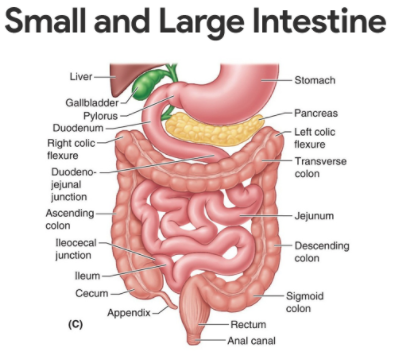
Process of nutrition in different organisms.
That is to say, diverse organisms take food material in by the process of nutrition which is used in cells to provide energy for various life processes in different ways. For example: Some use oxygen in the process and some do not.
The first step is the break-down of glucose, a six-carbon molecule, into a three-carbon molecule called pyruvate. This process takes place in the cytoplasm. Further, the pyruvate may be converted into ethanol and carbon dioxide. Similarly, beakdown of pyruvate using oxygen takes place in the mitochondria.
The chart of the processes are given below:
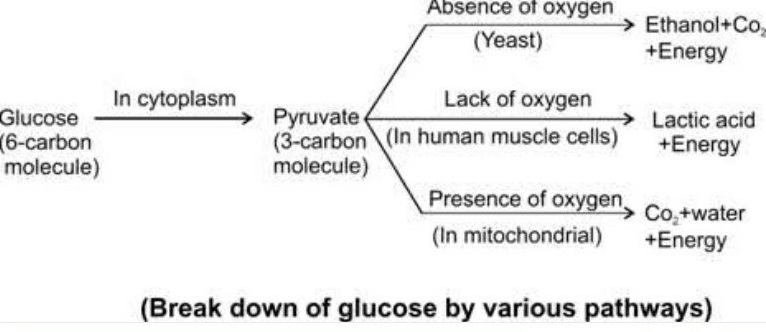
The energy released during cellular respiration is immediately used to synthesise a molecule called ATP which is used to fuel all other activities in the cell. In these processes, ATP is broken down giving rise to a fixed amount of energy which can drive the endothermic reactions taking place in the cell. Since the aerobic respiration pathway depends on oxygen, aerobic organisms need to ensure that there is sufficient intake of oxygen.
We have seen that plants exchange gases through stomata, and the large intercellular spaces ensure that all cells are in contact with air. Carbon dioxide and oxygen are exchanged by diffusion here. They can go into cells, or away from them and out into the air.
However, animals have evolved different organs for the uptake of oxygen from the environment and for getting rid of the carbon dioxide produced.
In human beings,
- Firstly, air is taken into the body through the nostrils.
- The air passing through the nostrils is filtered by fine hairs that line the passage.
- The passage is also lined with mucus which helps in this process.
- From here, the air passes through the throat and into the lungs.
- Rings of cartilage are present in the throat.
- These ensure that the air-passage does not collapse.
- Within the lungs, the passage divides into smaller and smaller tubes which finally terminate in balloon-like structures which are called alveoli.
- We lift our ribs and flatten our diaphragm, and the chest cavity becomes larger as a result. Because of this, air is sucked into the lungs and fills the expanded alveoli.
- Lastly, the oxygen in the alveolar air is taken up by blood in the alveolar blood vessels to be transported to all the cells in the body.
Life Processes Class 10 Notes Science Chapter 6 : TRANSPORTATION
Transportation in Human Beings
Blood is a fluid connective tissue.
Blood consists of a fluid medium called plasma in which the cells are suspended.
Oxygen is carried by the red blood cells.
We need a pumping organ to push blood around the body, a network of tubes to reach all the tissues and a system in place to ensure that this network can be repaired if damaged.
The heart
- So, we know that the heart is a muscular organ. It is as big as our fist.
- Both oxygen and carbon dioxide have to be transported by the blood, the heart has different chambers to prevent the oxygen-rich blood from mixing with the blood containing carbon dioxide.
- The carbon dioxide-rich blood has to reach the lungs for the carbon dioxide to be removed
- The oxygenated blood from the lungs has to be brought back to the heart.
- The process of pumping of blood is:
- Oxygen-rich blood from the lungs comes to the thin-walled upper chamber of the heart on the left, the left atrium.
- The left atrium relaxes when it is collecting this blood.
- It then contracts, while the next chamber, left ventricle, expands, so that the blood is transferred to it.
- Left ventricle contracts and the blood is pumped out to the body.
- Deoxygenated blood comes from the body to the upper chamber on the right, the right atrium, as it expands.
- Right atrium contracts, the corresponding lower chamber, the right ventricle, dilates.
- Blood to the right ventricle, which in turn pumps it to the lungs for oxygenation.
- Since ventricles have to pump blood into various organs, they have thicker muscular walls than the atria do.
- Valves ensure that blood does not flow backwards when the atria or ventricles contract
Oxygen enters the blood in the lungs
The blood goes only once through the heart in the fish during one cycle of passage through the body.
It goes through the heart in humans twice during each cycle in other vertebrates. This is known as double circulation.

The tubes – blood vessels
Arteries are the vessels which carry blood away from the heart to various organs of the body.
The blood emerges from the heart under high pressure, the arteries have thick, elastic walls.
Veins collect the blood from different organs and bring it back to the heart. They have valves that ensure that the blood flows only in one direction.
The artery divides into smaller and smaller vessels to bring the blood in contact with all the individual cells. The smallest vessels have walls which are one-cell thick and are called capillaries. The capillaries then join together to form veins that convey the blood away from the organ or tissue.
Maintenance by platelets
Blood has platelet cells which circulate around the body and plug the leaks or blood injury by helping to clot the blood at these points of injury.
Lymph
This is called lymph or tissue fluid.
Through the pores present in the walls of capillaries some amount of plasma, proteins and blood cells escape into intercellular spaces in the tissues to form the tissue fluid or lymph.
It is similar to the plasma of blood but colourless and contains less protein. Lymph drains into lymphatic capillaries from the intercellular spaces, which join to form large lymph vessels that finally open into larger veins. Lymph carries digested and absorbed fat from intestine and drains excess fluid from extracellular space back into the blood.
Transportation in Plants
If the distances between soil-contacting organs and chlorophyll containing organs are small, energy and raw materials can easily diffuse to all parts of the plant body. But if these distances become large because of changes in plant body design, diffusion processes will not be sufficient to provide raw material in leaves and energy in roots. A proper system of transportation is therefore essential in such situations.
That is to say, energy needs differ between different body designs.
Transport of water
In xylem tissue, vessels and tracheids of the roots, stems and leaves are interconnected. They form a continuous system of water-conducting channels reaching all parts of the plant. At the roots, cells in contact with the soil actively take up ions. This creates a difference in the concentration of these ions between the root and the soil. Water thus moves into the root from the soil to eliminate this difference. Thus there is steady movement of water into root xylem, creating a column of water that is steadily pushed upwards.
If a plant has an adequate supply of water, the water which is lost through the stomata is replaced by water from the xylem vessels in the leaf. Evaporation of water molecules from the cells of a leaf creates a suction which pulls water from the xylem cells of roots. The loss of water in the form of vapour from the aerial parts of the plant is known as transpiration.
Thus, transpiration helps in the absorption and upward movement of water and minerals dissolved in it from roots to the leaves. It also helps in temperature regulation. The effect of root pressure in transport of water is more important at night. During the day when the stomata are open, the transpiration pull becomes the major driving force in the movement of water in the xylem.
Transport of food and other substances
Transport of soluble products of photosynthesis is called translocation. It occurs in the part of the vascular tissue known as phloem. The phloem transports amino acids and other substances. These substances are especially delivered to the storage organs of roots, fruits and seeds and to growing organs. The translocation of food and other substances takes place in the sieve tubes with the help of adjacent companion cells both in upward and downward directions.
Materials like sucrose is transferred into phloem tissue using energy from ATP. This increases the osmotic pressure of the tissue causing water to move into it. Above all, this pressure moves the material in the phloem to tissues which have less pressure. This allows the phloem to move material according to the plant’s needs.
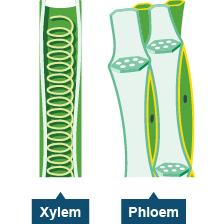
Life Processes Class 10 Notes Science Chapter 6 : EXCRETION
The biological process involved in the removal of these harmful metabolic wastes from the body is called excretion. Different organisms use varied strategies to do this.
Excretion in Human Beings
The excretory system of human beings includes a pair of kidneys, a pair of ureters, a urinary bladder and a urethra. Urine produced in the kidneys passes through the ureters into the urinary bladder where it is stored until it is released through the urethra.
The purpose of making urine is to filter out waste products from the blood. Just as CO2 is removed from the blood in the lungs, nitrogenous waste such as urea or uric acid are removed from blood in the kidneys. Similarly, there are capillary clusters in the kidney which is associated with the cup-shaped end of a tube that collects the filtered urine.
Further, each kidney has large numbers of these filtration units called nephrons packed close together.
It also selectively reabsorbs glucose, amino acids, salts and a major amount of water. The amount of water reabsorbed depends on how much excess water there is in the body.
The urine forming in each kidney eventually enters a long tube, the ureter. It is connected with the kidneys and the urinary bladder. Urine is stored in the urinary bladder until the pressure of the expanded bladder leads to the urge to pass it out through the urethra.
The bladder is muscular, so it is under nervous control.
As a result, we can usually control the urge to urinate.
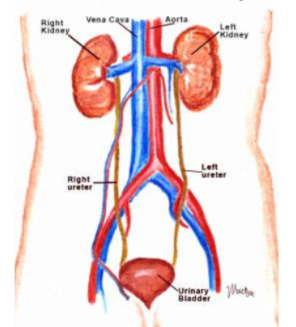
Excretion in Plants
Plants use completely different strategies for excretion than those of animals. Oxygen itself can be thought of as a waste product generated during photosynthesis.
They can get rid of excess water by transpiration.
- Plants use the fact that many of their tissues consist of dead cells, and that they can even lose some parts such as leaves.
- Plant waste products are stored in cellular vacuoles.
- Waste products may be stored in leaves that fall off.
- Other waste products are stored as resins and gums, especially in old xylem.
- Plants also excrete some waste substances into the soil around them.
Life Processes Class 10 Notes Science Chapter 6 – Questions and Answers
The kidneys in human beings are a part of the system for
(a) nutrition.
(b) respiration.
(c) excretion.
(d) transportation.
Ans. (c) excretion.
The xylem in plants are responsible for
(a) transport of water.
(b) transport of food.
(c) transport of amino acids.
(d) transport of oxygen.
Ans. (a) transport of water.
The autotrophic mode of nutrition requires
(a) carbon dioxide and water.
(b) chlorophyll.
(c) sunlight.
(d) all of the above.
Ans. (d) all of the above.
The breakdown of pyruvate to give carbon dioxide, water and energy takes place in
(a) cytoplasm.
(b) mitochondria.
(c) chloroplast.
(d) nucleus.
Ans. (b) mitochondria.
How are fats digested in our bodies? Where does this process take place?
Ans. The food coming from the stomach is acidic and has to be made alkaline for the pancreatic enzymes to act. Bile juice from the liver accomplishes this in addition to acting on fats.
The pancreas secretes pancreatic juice which contains enzymes like trypsin for digesting proteins and lipase for breaking down emulsified fats.
The walls of the small intestine contain glands which secrete intestinal juice. The enzymes present in it finally convert the proteins to amino acids, complex carbohydrates into glucose and fats into fatty acids and glycerol. They are finally taken up in our blood.
What is the role of saliva in the digestion of food?
Ans. The saliva contains an enzyme called salivary amylase that breaks down starch which is a complex molecule to give sugar. The food is mixed thoroughly with saliva and moved around the mouth while chewing by the muscular tongue.
What are the necessary conditions for autotrophic nutrition and what are its byproducts?
Ans. The necessary conditions for autotrophic nutrition are light, carbon dioxide and water should reach a cell which contains chlorophyll in it.
The byproduct of the autotrophic nutrition is oxygen which is released through stomata.
What are the differences between aerobic and anaerobic respiration?
Ans. The aerobic respiration pathway depends on oxygen. The anaerobic respiration pathway does not depend on oxygen,
How are the alveoli designed to maximise the exchange of gases?
Ans. The alveoli are balloon shaped structures which increases the surface area for the exchange of gases and are richly supplied with blood vessels.
What would be the consequences of a deficiency of haemoglobin in our bodies?
Ans. The consequences of a deficiency of haemoglobin in our bodies less energy in our body, leads to a disease called anaemia.
Describe double circulation in human beings. Why is it necessary?
Ans. The body of human beings are large and so is the energy demand of human beings too, hence it is necessary for the separation of oxygenated and deoxygenated blood to meet this energy demand since it allows better fusion of oxygen to the blood.
What are the differences between the transport of materials in xylem and phloem?
Ans. Water and minerals are transported through xylem.
Food is mainly transported through phloem.
Life Processes Class 10 Notes Science Chapter 6 – Conclusion
Life Processes are very important for living organisms and it ensures that the living being is healthy. If there is any defect in any life process it can prove to be fatal. In that case one must visit a doctor and have a checkup. We should have checkups periodically to ensure that we are healthy. Life Processes Class 10 Notes Science Chapter 6 is a brief introduction to all of the processes we will learn more in higher classes.

